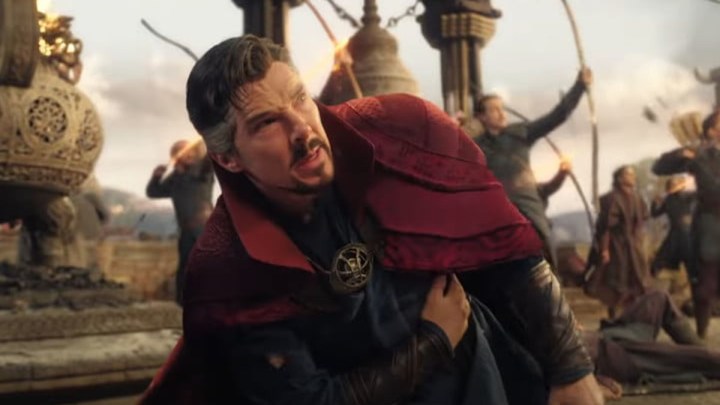It’s hard to remember a time when comic book movies didn’t dominate the big screen. Nowadays, there’s a franchise film every month, and analysts and film enthusiasts expect them to cross the half-billion mark with ease. The best-performing films reach up to $1 billion, with a lucky few either surpassing $2 billion or coming extremely close. Yes, superhero properties are the order of the day, and audiences can’t seem to get enough. It wasn’t always like that, and it wasn’t until the dawn of the 21st century that comic book-based films began their journey to become the juggernauts they are today, thanks in large part to one Sam Raimi.
More than the Superman films of the ’70s or the Batman saga of the ’90s, the Spider-Man franchise of the early 2000s redefined what a superhero property could be. Mixing humor, spectacle, and thematic resonance, Sony’s webslinger trilogy launched the modern superhero craze and cemented Spider-Man as the definitive millennial hero. A perfect combination of elements collided to make the Spider-Man trilogy a pillar of modern blockbuster cinema, but Raimi’s hand pulled the strings, gently guiding them home and turning the first two entries in his Spidey series into two of the best superhero films of all time.
The man who would be king (of the genre)

On paper, Raimi was a no-brainer choice to direct a superhero property. His films are famous for their dynamism and color, a hectic vibe that injects everything with erratic energy. Raimi pays special attention to movement and flow; something as simple as a character walking from one side to the other can become an exercise in style. A Raimi film will be in on the joke. It might not take itself seriously but will never mock or undermine its characters’ struggles. It will juggle resonant themes with genuine emotion without ever forgetting the humor behind it. Raimi’s films are careful and controlled chaos, a perfect approach to comic book adaptations, a genre that’s never been famous for respecting boundaries or continuity.
Still, some expressed skepticism at Raimi’s potential approach to a comic book film. After all, the director was famous specifically for his love of horror. Raimi’s career began with the unexpected success of the cult classic The Evil Dead, but it was the sequel, Evil Dead II, that catapulted him to stardom and cemented him as an undisputed horror auteur. Raimi’s fondness for comic books was ever-present in his career. In 1990, he created his own superhero, Darkman, who headlined the film of the same name. Raimi’s love of horror and black humor was a perfect fit for Darkman’s noir world, and the film received positive reviews from critics and was a sleeper hit.
Darkman was pretty much an audition for Raimi and the perfect example of how well the director’s style fit with the comic book genre. Darkman is gruesome and unrestrained, embracing the campier tones that comic books have always flaunted proudly. However, Raimi imbues the film with a distinct sense of tragedy, a veil of gloom that floats over it, even in the broadest scenes. Darkman is a tragic hero who is tortured, physically and mentally scarred, unstoppable, and broken. Brought to life by the appropriately stoic Liam Neeson, Darkman is a complex creation that would feel right at home next to modern-day antiheroes like Walter White.
Raimi has always been ahead of his time. It’s no surprise that his films often get reappraised years after they debut to mixed reviews. Movies like The Quick and the Dead and the slapstick camp-fest that is Army of Darkness have been positively reviewed by modern critics and fans alike, becoming certified cult classics. Raimi’s style isn’t for everyone; it’s too in-your-face, bold and unconcerned, and often overwhelming for some. However, while that might not work in a revisionist Western, it sure as heck is a perfect fit for a comic book adaptation,
Reinventing Spider-Man

Spider-Man is arguably Marvel’s definitive superhero. He shares a place of honor alongside DC’s Superman, Batman, and Wonder Woman as one of those characters that embody the entire comic book genre. In many ways, Spidey is the ultimate hero: He’s courageous but not unafraid, always available but fiercely protective of his personal life, charismatic in action yet infallible in battle. Spider-Man is clumsy but charming, suave but relatable, the perfect combination of brains, brawn, and above all, heart. Most importantly, Spider-Man is a tragic character; every single win comes accompanied by an even bigger loss. Spider-Man loses his parents, uncle, best friend, love interest, and, on occasion, even his life. Yet he never stops finding the humor in his situation and never gives up.
Raimi understood Spider-Man and created a film that perfectly captured the web crawler’s essence. Spider-Man was the film fans wanted and deserved in 2002. Raimi was faithful to the comics while still adding his distinctive flair to the friendly neighborhood Spider-Man’s story. The film was fast-paced and bright, not only embracing but celebrating the inherent ridiculousness of a teenager in tights swinging around New York City. Every scene was brisk and dynamic, as Spider-Man jumped from side to side while the Green Goblin chased him with maniacal glee. Spider-Man was a comic book brought to life, accompanied by all the “BOOMS!” and “BANGS!” fans expected.
Earnest and playful, Spider-Man legitimized the comic book genre’s natural over-the-top nature. The film didn’t go for a grounded approach or try to make the web crawler’s powers more palatable for audiences. On the contrary, the film doubled up on the exaggeration and silliness, making Peter’s webs organic and turning Green Goblin into a scenery-chewing, mustache-twirling villain, complete with a suitably unhinged performance by Willem Dafoe, whose diet included every bit of scenery to chew on. However, Raimi never took his characters for granted; where others saw ridicule, Raimi saw beauty and awe, a chance to inspire and dazzle.
What so many other comic book films that followed failed to understand is that the genre’s natural absurdity doesn’t automatically make it disposable. Raimi provided his characters with clear and deeply human struggles and intelligent comedy that complemented rather than insulted them. Future comic book projects discarded these crucial elements in favor of action set pieces and cheap humor. But a comic book movie — and any action movie, for that matter — is more than just explosions and chase sequences, and no director understands this better than Raimi.
Indeed, Raimi’s best films are a perfect combination of genres and themes, creating a sense of order that never quite disrupts the chaos. Spider-Man and, in particular, Spider-Man 2 constantly juggle action and humor while also adding coming-of-age, romance, and even horror elements. The result is a duo of movies that never stop, going from one genre to another with ease and comfort; it might not be seamless, but it’s always entertaining.
Doctor Strange in the multiverse of Raimi

Spider-Man 3 ended Raimi’s trilogy in a bitter yet satisfying-enough way. Talks of a possible fourth entry lingered for years, even as Andrew Garfield’s rebooted series came and went and the web crawler joined the massive beast that is the MCU, this time played by Tom Holland. Raimi himself moved on, returning to horror with the underrated Drag Me to Hell and exploring the fantasy genre with the shameless cash grab that was Oz: The Great and Powerful. Fans seemed pleased with Holland and the MCU’s take on Spider-Man, and it seemed like Raimi was effectively done with the comic book genre. And then, Doctor Strange in the Multiverse of Madness happened.
When Marvel announced that Raimi would take over the Doctor Strange sequel, fans went into a frenzy. The director that effectively launched the modern wave of superhero craze was finally joining the franchise that, in many ways, directly resulted from his original Spider-Man trilogy. Furthermore, with his mystical and somewhat macabre vibes, Doctor Strange was the perfect chance for Raimi to flex his horror-loving muscles.
And flex he did. Doctor Strange in the Multiverse of Madness is chaos of the highest order. Far more sinister than anything the MCU has ever done — or will do, probably — Multiverse of Madness has all the qualities of a Sam Raimi film without ever fully becoming one. However, mainly thanks to the MCU’s factory-produced films, Multiverse of Madness‘s Raimi-isms are obvious. Elements of body horror and gore, so typical in Raimi’s other films, are barely there in Multiverse of Madness, yet become bright standouts considering how vanilla the rest of the MCU is. It’s clear that Raimi didn’t have full creative freedom from Marvel’s massive worldbuilding machine, but he received just enough liberty to imbue the film with his brand of horror. Moreover, Raimi’s love for the genre comes across in every frame, adding a welcome sense of artistry and appreciation to a franchise that has long been looked down on for representing the bastardization of the film industry.
A legacy for the ages

Raimi’s cinematic legacy was cemented even before the Spider-Man trilogy. As one of horror’s most famous auteurs and a highly experimental director, Raimi is revered by critics and filmmakers alike. However, his influence on the comic book genre is even more impressive. Along with directors like Christopher Nolan, Tim Burton, and Richard Donner, Raimi redefined what a comic book film could be. He provided a clear and refreshing purpose to the genre, proving that a superhero property could have as much thematic weight as any other film. Raimi humanized a genre that had been unreachable and unfocused for so long, validating it in the eyes of its harshest critics.
Without Raimi, the legitimization of the comic book genre would ha’ve fallen squarely onto Nolan’s cynical shoulders. But Nolan’s bleak and hyper-realistic approach doesn’t work for all superheroes, nor should it. Raimi proved that there’s value in the comic book genre’s exaggeration; it’s the thing that sets it apart from other movies. Raimi’s heroes laugh at each other, and we laugh with them. However, we also suffer with them, cry and root and celebrate because we care. That’s the key to Raimi’s success. He cares as much about the suit as the man wearing it. Raimi’s superpower is empathy for his creations, heroes and monsters alike. In Raimi’s eyes, everyone is a bit of both, even Spider-Man. The comic book genre would be much better if everyone felt the same.
Editors' Recommendations
- Which multiverse is better: Marvel or DC?
- 7 Marvel movies that should have ended differently
- The best Spider-Man characters in the Sam Raimi trilogy
- Doctor Strange 2 writer on Sam Raimi and Marvel’s multiverse
- Everything you need to know about Doctor Strange




